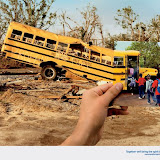 Belgian Ello Mobile is a mobile operator that was established with the sole aim of giving away 100% of its profits. Ello is a mobile virtual network operator – it uses an existing network. Instead of offering bargain-basement cellphone plans, the company offers its customers the chance to contribute directly to a cause with every call they make, and every text message they send.
Belgian Ello Mobile is a mobile operator that was established with the sole aim of giving away 100% of its profits. Ello is a mobile virtual network operator – it uses an existing network. Instead of offering bargain-basement cellphone plans, the company offers its customers the chance to contribute directly to a cause with every call they make, and every text message they send. Again, consumers are fed up with charity related campaigns, but more then ever they appreciate fun ways to participate
According to Serge Van de Zande, co-founder of Ello Mobile who keynoted at the Vlerick Colloquium in Ghent in Marsch, he knows
Consumers become more and more indifferent towards "price and promo-related telecom campaigns"
While:
- 8,6 Million people in Belgium own a Mobile phone, and Telecom marketing weight that relates
to promo and price is very heavy
- 6 out of 10 does the effort of giving a yearly donation to a charitative initiative
- Engagement is hot, preferably in a pleasant and easy way to consume
On top of that: Global awarenes did enter the mainstream of consumerism, and is a niche anymore for a few neo-hippies.
How easy is Ello Mobile?
Customers can currently pick one of six projects, from protecting the jungles of Sumatra to providing mobile schools to street children in South America. Another six projects will be added over the next few months, all of which have been selected by an independent panel of experts. Ello understands the need for charitable organizations to be completely transparent, and will share full profit and loss statements with its customers. To minimize costs, the company is entirely web-based, and works with a small administrative staff. Profit margins are forecast at 24-33% for the first three years, and are targeted to climb to 41% after 2009.
Tommy Telecom
Meanwhile, just launched in the Netherlands, Tommy Telecom is also forging a link between social causes and mobile telecom. Albeit with a very different approach. Tommy's customers are required to structurally donate time or money to a recognized cause. Which means their customer base is 5 million Dutch citizens.
Like Ello, Tommy Telcom is a virtual mobile provider, operating on KPN's network. Unlike Ello, Tommy offers cheap cell phone plans. For EUR 5 per month, members can call other members at no charge, and non-members at EUR 0,15 per minute. Here, the goal isn't to give away profits, but to offer socially engaged consumers a reward for sponsoring causes and an extra incentive to keep donating. And of course the scheme will also encourage members to ask their friends and family to sign up too, so that all involved can call more people for free.
Whether you make it easy or rewarding for your customers to be good, turning existing consumer behaviour into a way of contributing to a better world is innovation we applaud.

















